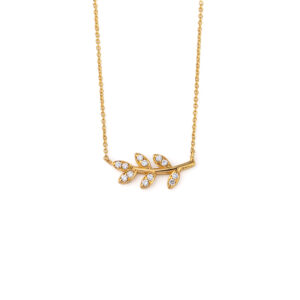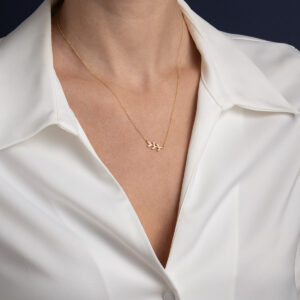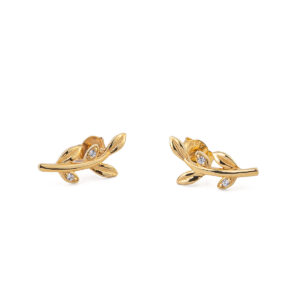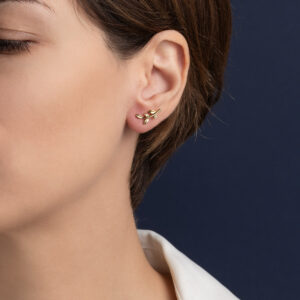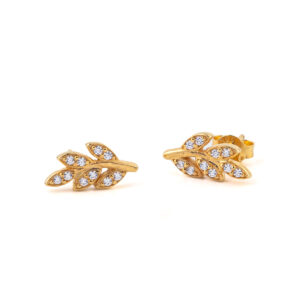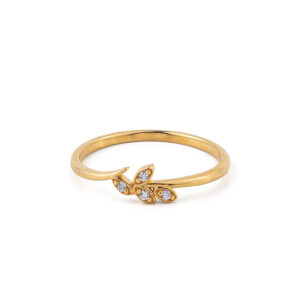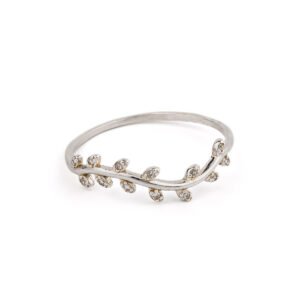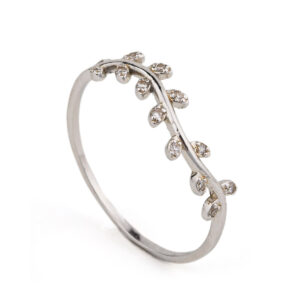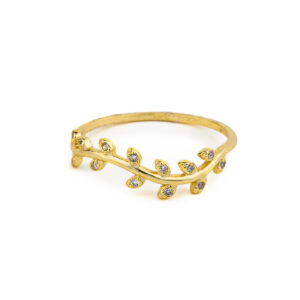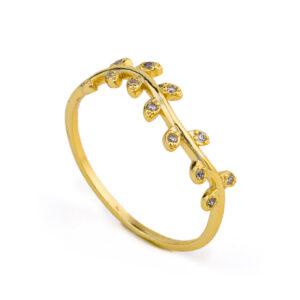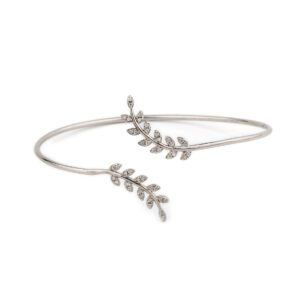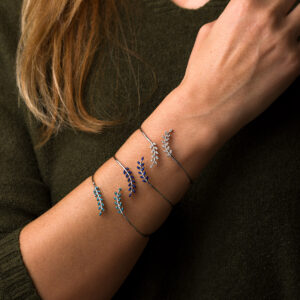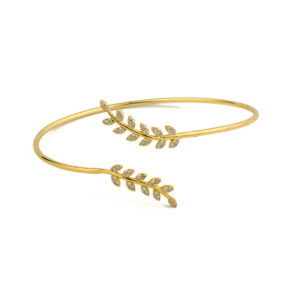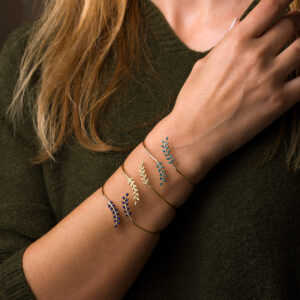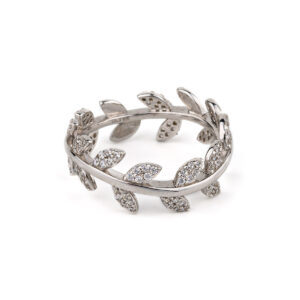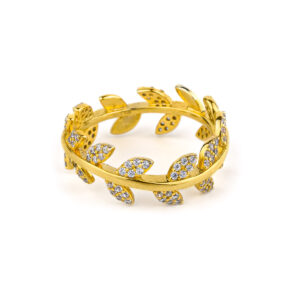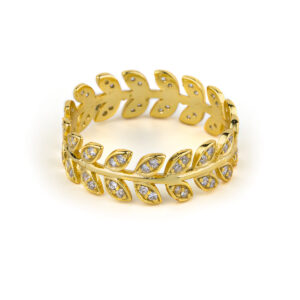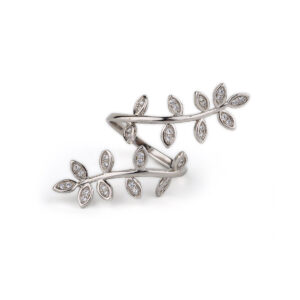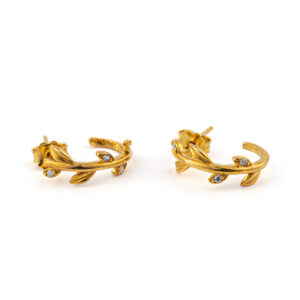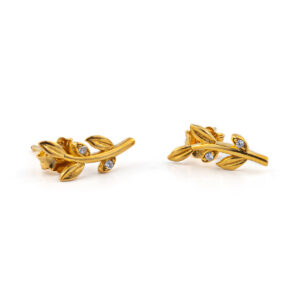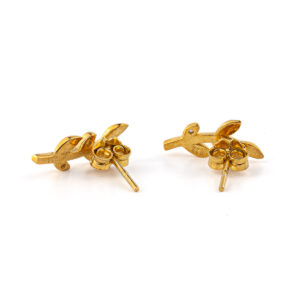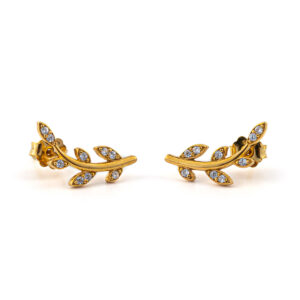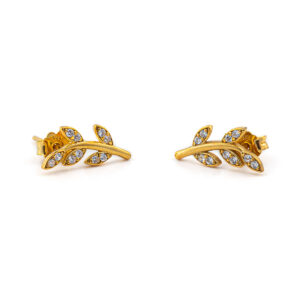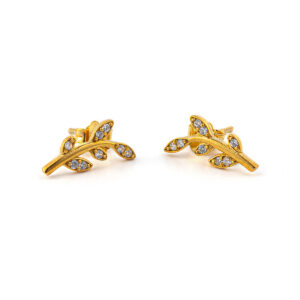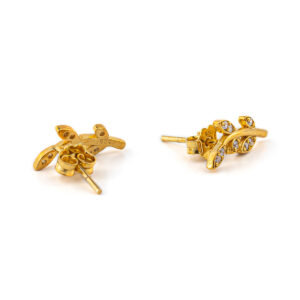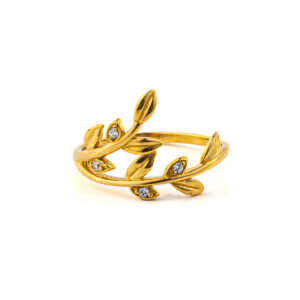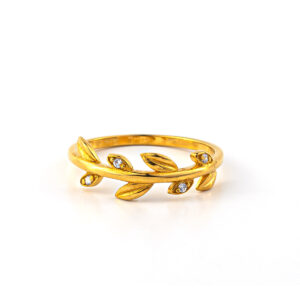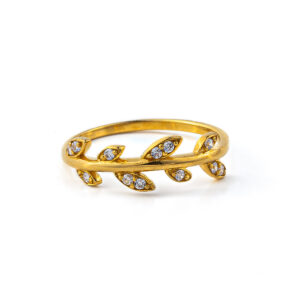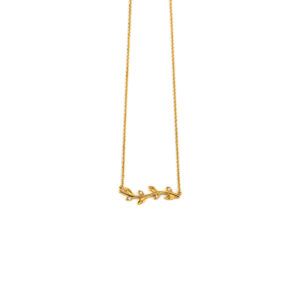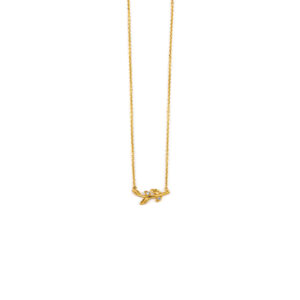Η συλλογή μας Ελιά, είναι εμπνευσμένη από την αρχαία ελληνική ιστορία και ιδιαίτερα από την ελληνική γη. Περιλαμβάνει μοναδικά χειροποίητα κοσμήματα, σκουλαρίκια, δαχτυλίδια, βραχιόλια, καρφίτσες με φύλλα ελιάς και πολύτιμους λίθους σε Ασήμι ή Χρυσό. Η ελιά στην Αρχαία Ελλάδα ήταν σύμβολο του Ολυμπιακού ιδεώδους, αφού ένα κλαδί ελιάς ήταν το μοναδικό έπαθλο για τους Ολυμπιονίκες. Η ελιά συμβολίζει την ειρήνη, τη νίκη, την τιμή και την ευημερία.
Κολιέ Φύλλο Ελιάς με Ζιργκόν – Χρυσό 18Κ
745,00€Βραχιόλι εμπνευσμένο από το σύμβολο του φύλλου της ελιάς.
Από χρυσό 18 καρατίων με ζιργκόν.
Το στεφάνι ελιάς, γνωστό και ως κότινο, ήταν το βραβείο για τον νικητή στους αρχαίους Ολυμπιακούς Αγώνες. Ήταν ένα κλαδί ελιάς, από την αγριελιά που φύτρωνε στην Ολυμπία,πλεγμένο σε κύκλο ή πέταλο. Σύμφωνα με τον Παυσανία εισήχθη από τον Ηρακλή ως έπαθλο για τον νικητή του αγώνα δρόμου προς τιμήν του πατέρα του Δία. Στους αρχαίους Ολυμπιακούς Αγώνες δεν υπήρχαν χρυσά, ασημένια ή χάλκινα μετάλλια. Υπήρχε μόνο ένας νικητής ανά αγώνισμα, ο οποίος στεφανωνόταν με ένα στεφάνι ελιάς από φύλλα αγριελιάς από ένα ιερό δέντρο κοντά στο ναό του Δία στην Ολυμπία. Στεφάνια ελιάς μοιράστηκαν κατά τη διάρκεια των θερινών Ολυμπιακών Αγώνων του 2004 στην Αθήνα προς τιμήν της αρχαίας παράδοσης, επειδή οι αγώνες διεξάγονταν στην Ελλάδα.
Χειροποίητο Ελληνικό Κόσμημα
Ανακαλύψτε τη Συλλογή Ελιά
Σκουλαρίκια Φύλλο Ελιάς με Ζιργκόν – Χρυσό 9Κ
250,00€Σκουλαρίκια εμπνευσμένα από το σύμβολο του φύλλου της ελιάς.
Από χρυσό 9 καρατίων με ζιργκόν.
Το στεφάνι ελιάς, γνωστό και ως κότινο, ήταν το βραβείο για τον νικητή στους αρχαίους Ολυμπιακούς Αγώνες. Ήταν ένα κλαδί ελιάς, από την αγριελιά που φύτρωνε στην Ολυμπία, πλεγμένο σε κύκλο ή πέταλο. Σύμφωνα με τον Παυσανία εισήχθη από τον Ηρακλή ως έπαθλο για τον νικητή του αγώνα δρόμου προς τιμήν του πατέρα του Δία. Στους αρχαίους Ολυμπιακούς Αγώνες δεν υπήρχαν χρυσά, ασημένια ή χάλκινα μετάλλια. Υπήρχε μόνο ένας νικητής ανά αγώνισμα, ο οποίος στεφανωνόταν με ένα στεφάνι ελιάς από φύλλα αγριελιάς από ένα ιερό δέντρο κοντά στο ναό του Δία στην Ολυμπία. Τα στεφάνια ελιάς μοιράστηκαν κατά τη διάρκεια των θερινών Ολυμπιακών Αγώνων του 2004 στην Αθήνα προς τιμήν της αρχαίας παράδοσης, επειδή οι αγώνες διεξάγονταν στην Ελλάδα.
Ανακαλύψτε τη Συλλογή Ελιά
Σκουλαρίκια Φύλλα Ελιάς με Ζιργκόν – Χρυσό 14Κ
390,00€Σκουλαρίκια εμπνευσμένα από το σύμβολο του φύλλου της ελιάς.
Από χρυσό 14 καρατίων με ζιργκόν.
Το στεφάνι ελιάς, γνωστό και ως κότινο, ήταν το βραβείο για τον νικητή στους αρχαίους Ολυμπιακούς Αγώνες. Ήταν ένα κλαδί ελιάς, από την αγριελιά που φύτρωνε στην Ολυμπία, πλεγμένο σε κύκλο ή πέταλο. Σύμφωνα με τον Παυσανία εισήχθη από τον Ηρακλή ως έπαθλο για τον νικητή του αγώνα δρόμου προς τιμήν του πατέρα του Δία. Στους αρχαίους Ολυμπιακούς Αγώνες δεν υπήρχαν χρυσά, ασημένια ή χάλκινα μετάλλια. Υπήρχε μόνο ένας νικητής ανά αγώνισμα, ο οποίος στεφανωνόταν με ένα στεφάνι ελιάς από φύλλα αγριελιάς από ένα ιερό δέντρο κοντά στο ναό του Δία στην Ολυμπία. Στεφάνια ελιάς μοιράστηκαν κατά τη διάρκεια των θερινών Ολυμπιακών Αγώνων του 2004 στην Αθήνα προς τιμήν της αρχαίας παράδοσης, επειδή οι αγώνες διεξάγονταν στην Ελλάδα.
Χειροποίητο Ελληνικό Κόσμημα
Ανακαλύψτε τη Συλλογή Ελιά
Δαχτυλίδι Ελιάς με Ζιργκόν – Χρυσό 14Κ
249,00€Δαχτυλίδι εμπνευσμένο από το σύμβολο του φύλλου της ελιάς.
Από χρυσό 14 καρατίων με ζιργκόν.
Το στεφάνι ελιάς, γνωστό και ως κότινο, ήταν το βραβείο για τον νικητή στους αρχαίους Ολυμπιακούς Αγώνες. Ήταν ένα κλαδί ελιάς, από την αγριελιά που φύτρωνε στην Ολυμπία,πλεγμένο σε κύκλο ή πέταλο. Σύμφωνα με τον Παυσανία εισήχθη από τον Ηρακλή ως έπαθλο για τον νικητή του αγώνα δρόμου προς τιμήν του πατέρα του Δία. Στους αρχαίους Ολυμπιακούς Αγώνες δεν υπήρχαν χρυσά, ασημένια ή χάλκινα μετάλλια. Υπήρχε μόνο ένας νικητής ανά αγώνισμα, ο οποίος στεφανωνόταν με ένα στεφάνι ελιάς από φύλλα αγριελιάς από ένα ιερό δέντρο κοντά στο ναό του Δία στην Ολυμπία. Στεφάνια ελιάς μοιράστηκαν κατά τη διάρκεια των θερινών Ολυμπιακών Αγώνων του 2004 στην Αθήνα προς τιμήν της αρχαίας παράδοσης, επειδή οι αγώνες διεξάγονταν στην Ελλάδα.
Χειροποίητο Ελληνικό Κόσμημα
Ανακαλύψτε τη Συλλογή Ελιά
Olive Leaf Ring with Zircon – Sterling Silver
The olive tree in Ancient Greece was a symbol of the Olympic ideal, since an olive branch was the only prize for the Olympic champions. Τhe olive tree symbolizes peace, victory, honor and prosperity.
Made of 925⁰ sterling silver.
Handmade item.
Olive Leaf Ring with Zircon – Sterling Silver and Rose Gold Plated
The olive tree in Ancient Greece was a symbol of the Olympic ideal, since an olive branch was the only prize for the Olympic champions. Τhe olive tree symbolizes peace, victory, honor and prosperity.
Made of 925⁰ sterling silver.
Handmade item.
Olive Leaf Ring with Zircon – 925 Sterling Silver and Gold Plated
The olive tree in Ancient Greece was a symbol of the Olympic ideal, since an olive branch was the only prize for the Olympic champions. Τhe olive tree symbolizes peace, victory, honor and prosperity.
Made of 925⁰ sterling silver.
Handmade item.
Βραχιόλι Bangle Ελιά με Ζιργκόν – Ασήμι 925
Βραχιόλι Bangle Ελιά με Ζιργκόν
Κατασκευασμένο από ασήμι 925⁰.
Χειροποίητο ελληνικό κόσμημα.
Βραχιόλι Bangle Ελιά με Ζιργκόν – Ασήμι 925 Επιχρυσωμένο
Βραχιόλι Bangle Ελιά με Ζιργκόν.
Κατασκευασμένο από επιχρυσωμένο ασήμι 925⁰.
Χειροποίητο ελληνικό κόσμημα.
Olive Leaf Zircon Ring – 925 Sterling Silver
Ring inspired by the olive leaf symbol.
Made of 925 Sterling Silver.
The olive wreath also known as kotinos was the prize for the winner at the ancient Olympic Games. It was an olive branch, of the wild- olive tree that grew at Olympia,intertwined to form a circle or a horse-shoe. According to Pausanias it was introduced by Heracles as a prize for the running race winner to honour his father Zeus. In the ancient Olympic Games there were no gold, silver, or bronze medals. There was only one winner per event, crowned with an olive wreath made of wild-olive leaves from a sacred tree near the temple of Zeus at Olympia. Olive wreaths were given out during the 2004 Summer Olympics in Athens in honor of the ancient tradition, because the games were being held in Greece.
Olive Leaf Zircon Ring – 925 Sterling Silver and Gold Plated
Ring inspired by the olive leaf symbol.
Made of 925 Sterling Silver and Gold Plated
The olive wreath also known as kotinos was the prize for the winner at the ancient Olympic Games. It was an olive branch, of the wild- olive tree that grew at Olympia,intertwined to form a circle or a horse-shoe. According to Pausanias it was introduced by Heracles as a prize for the running race winner to honour his father Zeus. In the ancient Olympic Games there were no gold, silver, or bronze medals. There was only one winner per event, crowned with an olive wreath made of wild-olive leaves from a sacred tree near the temple of Zeus at Olympia. Olive wreaths were given out during the 2004 Summer Olympics in Athens in honor of the ancient tradition, because the games were being held in Greece.
Olive Leaves Ring – 925 Sterling Silver and Gold Plated
Ring inspired by the olive leaf symbol.
Made of 925 Sterling Silver and Gold Plated
The olive wreath also known as kotinos was the prize for the winner at the ancient Olympic Games. It was an olive branch, of the wild- olive tree that grew at Olympia,intertwined to form a circle or a horse-shoe. According to Pausanias it was introduced by Heracles as a prize for the running race winner to honour his father Zeus. In the ancient Olympic Games there were no gold, silver, or bronze medals. There was only one winner per event, crowned with an olive wreath made of wild-olive leaves from a sacred tree near the temple of Zeus at Olympia. Olive wreaths were given out during the 2004 Summer Olympics in Athens in honor of the ancient tradition, because the games were being held in Greece.
Olive Leaf Branch Ring – 925 Sterling Silver
Ring inspired by the olive leaf symbol.
Made of 925 Sterling Silver.
The olive wreath also known as kotinos was the prize for the winner at the ancient Olympic Games. It was an olive branch, of the wild- olive tree that grew at Olympia,intertwined to form a circle or a horse-shoe. According to Pausanias it was introduced by Heracles as a prize for the running race winner to honour his father Zeus. In the ancient Olympic Games there were no gold, silver, or bronze medals. There was only one winner per event, crowned with an olive wreath made of wild-olive leaves from a sacred tree near the temple of Zeus at Olympia. Olive wreaths were given out during the 2004 Summer Olympics in Athens in honor of the ancient tradition, because the games were being held in Greece.
Σκουλαρίκια Κλαδί – 14Κ Χρυσό με Ζιργκόν
492,00€Earrings inspired by the olive leaf symbol.
Made of 14k gold with zircon.
The olive wreath also known as kotinos was the prize for the winner at the ancient Olympic Games. It was an olive branch, of the wild- olive tree that grew at Olympia,intertwined to form a circle or a horse-shoe. According to Pausanias it was introduced by Heracles as a prize for the running race winner to honour his father Zeus. In the ancient Olympic Games there were no gold, silver, or bronze medals. There was only one winner per event, crowned with an olive wreath made of wild-olive leaves from a sacred tree near the temple of Zeus at Olympia. Olive wreaths were given out during the 2004 Summer Olympics in Athens in honor of the ancient tradition, because the games were being held in Greece.
Σκουλαρίκια Κλαδί – 14Κ Χρυσό με Ζιργκόν
340,00€Earrings inspired by the olive leaf symbol.
Made of 14k gold with zircon.
The olive wreath also known as kotinos was the prize for the winner at the ancient Olympic Games. It was an olive branch, of the wild- olive tree that grew at Olympia,intertwined to form a circle or a horse-shoe. According to Pausanias it was introduced by Heracles as a prize for the running race winner to honour his father Zeus. In the ancient Olympic Games there were no gold, silver, or bronze medals. There was only one winner per event, crowned with an olive wreath made of wild-olive leaves from a sacred tree near the temple of Zeus at Olympia. Olive wreaths were given out during the 2004 Summer Olympics in Athens in honor of the ancient tradition, because the games were being held in Greece.
Σκουλαρίκια Κλαδί – 14Κ Χρυσό με Ζιργκόν
408,00€Earrings inspired by the olive leaf symbol.
Made of 14k gold with zircon.
The olive wreath also known as kotinos was the prize for the winner at the ancient Olympic Games. It was an olive branch, of the wild- olive tree that grew at Olympia,intertwined to form a circle or a horse-shoe. According to Pausanias it was introduced by Heracles as a prize for the running race winner to honour his father Zeus. In the ancient Olympic Games there were no gold, silver, or bronze medals. There was only one winner per event, crowned with an olive wreath made of wild-olive leaves from a sacred tree near the temple of Zeus at Olympia. Olive wreaths were given out during the 2004 Summer Olympics in Athens in honor of the ancient tradition, because the games were being held in Greece.
Σκουλαρίκια Κλαδί – 14Κ Χρυσό με Ζιργκόν
459,00€Earrings inspired by the olive leaf symbol.
Made of 14k gold with zircon.
The olive wreath also known as kotinos was the prize for the winner at the ancient Olympic Games. It was an olive branch, of the wild- olive tree that grew at Olympia,intertwined to form a circle or a horse-shoe. According to Pausanias it was introduced by Heracles as a prize for the running race winner to honour his father Zeus. In the ancient Olympic Games there were no gold, silver, or bronze medals. There was only one winner per event, crowned with an olive wreath made of wild-olive leaves from a sacred tree near the temple of Zeus at Olympia. Olive wreaths were given out during the 2004 Summer Olympics in Athens in honor of the ancient tradition, because the games were being held in Greece.
Σκουλαρίκια Κλαδί – 14Κ Χρυσό με Ζιργκόν
340,00€Earrings inspired by the olive leaf symbol.
Made of 14k gold with zircon.
The olive wreath also known as kotinos was the prize for the winner at the ancient Olympic Games. It was an olive branch, of the wild- olive tree that grew at Olympia,intertwined to form a circle or a horse-shoe. According to Pausanias it was introduced by Heracles as a prize for the running race winner to honour his father Zeus. In the ancient Olympic Games there were no gold, silver, or bronze medals. There was only one winner per event, crowned with an olive wreath made of wild-olive leaves from a sacred tree near the temple of Zeus at Olympia. Olive wreaths were given out during the 2004 Summer Olympics in Athens in honor of the ancient tradition, because the games were being held in Greece.
Δαχτυλίδι Κλαδί – 14Κ Χρυσό με Ζιργκόν
476,00€Ring inspired by the olive leaf symbol.
Made of 14k gold with zircon.
The olive wreath also known as kotinos was the prize for the winner at the ancient Olympic Games. It was an olive branch, of the wild- olive tree that grew at Olympia,intertwined to form a circle or a horse-shoe. According to Pausanias it was introduced by Heracles as a prize for the running race winner to honour his father Zeus. In the ancient Olympic Games there were no gold, silver, or bronze medals. There was only one winner per event, crowned with an olive wreath made of wild-olive leaves from a sacred tree near the temple of Zeus at Olympia. Olive wreaths were given out during the 2004 Summer Olympics in Athens in honor of the ancient tradition, because the games were being held in Greece.
Δαχτυλίδι Κλαδί – 14Κ Χρυσό με Ζιργκόν
408,00€Ring inspired by the olive leaf symbol.
Made of 14k gold with zircon.
The olive wreath also known as kotinos was the prize for the winner at the ancient Olympic Games. It was an olive branch, of the wild- olive tree that grew at Olympia,intertwined to form a circle or a horse-shoe. According to Pausanias it was introduced by Heracles as a prize for the running race winner to honour his father Zeus. In the ancient Olympic Games there were no gold, silver, or bronze medals. There was only one winner per event, crowned with an olive wreath made of wild-olive leaves from a sacred tree near the temple of Zeus at Olympia. Olive wreaths were given out during the 2004 Summer Olympics in Athens in honor of the ancient tradition, because the games were being held in Greece.
Δαχτυλίδι Κλαδί – 14Κ Χρυσό με Ζιργκόν
476,00€Ring inspired by the olive leaf symbol.
Made of 14k gold with zircon.
The olive wreath also known as kotinos was the prize for the winner at the ancient Olympic Games. It was an olive branch, of the wild- olive tree that grew at Olympia,intertwined to form a circle or a horse-shoe. According to Pausanias it was introduced by Heracles as a prize for the running race winner to honour his father Zeus. In the ancient Olympic Games there were no gold, silver, or bronze medals. There was only one winner per event, crowned with an olive wreath made of wild-olive leaves from a sacred tree near the temple of Zeus at Olympia. Olive wreaths were given out during the 2004 Summer Olympics in Athens in honor of the ancient tradition, because the games were being held in Greece.
Δαχτυλίδι Κλαδί – 14Κ Χρυσό με Ζιργκόν
459,00€Ring inspired by the olive leaf symbol.
Made of 14k gold with zircon.
The olive wreath also known as kotinos was the prize for the winner at the ancient Olympic Games. It was an olive branch, of the wild- olive tree that grew at Olympia,intertwined to form a circle or a horse-shoe. According to Pausanias it was introduced by Heracles as a prize for the running race winner to honour his father Zeus. In the ancient Olympic Games there were no gold, silver, or bronze medals. There was only one winner per event, crowned with an olive wreath made of wild-olive leaves from a sacred tree near the temple of Zeus at Olympia. Olive wreaths were given out during the 2004 Summer Olympics in Athens in honor of the ancient tradition, because the games were being held in Greece.
Δαχτυλίδι Κλαδί – 14Κ Χρυσό με Ζιργκόν
390,00€Ring inspired by the olive leaf symbol.
Made of 14k gold with zircon.
The olive wreath also known as kotinos was the prize for the winner at the ancient Olympic Games. It was an olive branch, of the wild- olive tree that grew at Olympia,intertwined to form a circle or a horse-shoe. According to Pausanias it was introduced by Heracles as a prize for the running race winner to honour his father Zeus. In the ancient Olympic Games there were no gold, silver, or bronze medals. There was only one winner per event, crowned with an olive wreath made of wild-olive leaves from a sacred tree near the temple of Zeus at Olympia. Olive wreaths were given out during the 2004 Summer Olympics in Athens in honor of the ancient tradition, because the games were being held in Greece.
Δαχτυλίδι Κλαδί – 14Κ Χρυσό με Ζιργκόν
323,00€Ring inspired by the olive leaf symbol.
Made of 14k gold with zircon.
The olive wreath also known as kotinos was the prize for the winner at the ancient Olympic Games. It was an olive branch, of the wild- olive tree that grew at Olympia,intertwined to form a circle or a horse-shoe. According to Pausanias it was introduced by Heracles as a prize for the running race winner to honour his father Zeus. In the ancient Olympic Games there were no gold, silver, or bronze medals. There was only one winner per event, crowned with an olive wreath made of wild-olive leaves from a sacred tree near the temple of Zeus at Olympia. Olive wreaths were given out during the 2004 Summer Olympics in Athens in honor of the ancient tradition, because the games were being held in Greece.
Δαχτυλίδι Κλαδί – 14Κ Χρυσό με Ζιργκόν
323,00€Ring inspired by the olive leaf symbol.
Made of 14k gold with zircon.
The olive wreath also known as kotinos was the prize for the winner at the ancient Olympic Games. It was an olive branch, of the wild- olive tree that grew at Olympia,intertwined to form a circle or a horse-shoe. According to Pausanias it was introduced by Heracles as a prize for the running race winner to honour his father Zeus. In the ancient Olympic Games there were no gold, silver, or bronze medals. There was only one winner per event, crowned with an olive wreath made of wild-olive leaves from a sacred tree near the temple of Zeus at Olympia. Olive wreaths were given out during the 2004 Summer Olympics in Athens in honor of the ancient tradition, because the games were being held in Greece.
Κολιέ Κλαδί – 14Κ Χρυσό με Ζιργκόν
390,00€Made in 14K gold with zircon.
A necklace inspired from the olive branch, a symbol of peace, abundance and achievement.
Handmade item.
Κολιέ Κλαδί – 14Κ Χρυσό με Ζιργκόν
390,00€Made in 14K gold with zircon.
A necklace inspired from the olive branch, a symbol of peace, abundance and achievement.
Handmade item.
Κολιέ Κλαδί – 14Κ Χρυσό με Ζιργκόν
289,00€Made in 14K gold with zircon.
A necklace inspired from the olive branch, a symbol of peace, abundance and achievement.
Handmade item.

